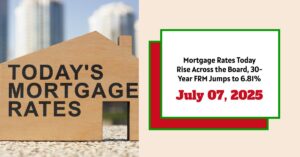Jumping into the housing market or considering a refinance? One of the first things you’ll want to know about are today's mortgage rates. According to Zillow, as of July 7, 2025, the national average for a 5-year Adjustable Rate Mortgage (ARM) has climbed to 7.56%, marking a significant increase of 27 basis points from the previous rate of 7.29%. Let's break down what this means for you, explore the broader rate environment, and discuss some strategies for navigating the current market.
Today's Mortgage Rates: 5-Year ARM Surges by 27 Basis Points to 7.56%
ARM Rates on the Rise: What's Happening?
The increase in 5-year ARM rates is particularly noteworthy. ARMs, as the name suggests, come with interest rates that are fixed for an initial period (in this case, five years) and then adjust periodically based on a benchmark interest rate.
Here's what you need to know about this increase:
- Short-Term Impact: This rise makes 5-year ARMs more expensive upfront, potentially impacting affordability for some borrowers.
- Long-Term Implications: Borrowers opting for a 5-year ARM are betting that interest rates will either stay the same or decrease after the initial fixed-rate period. If rates rise significantly, their monthly payments could jump up.
- Market Signals: The increase in ARM rates could signal changing expectations regarding future interest rate movements. Lenders are factoring in potential rate hikes into their pricing of ARMs.
Current Mortgage Rate Snapshot
Let's take a broader look at where mortgage rates stand across different loan types on July 7, 2025, according to Zillow:
Conforming Loans
| PROGRAM | RATE | 1W CHANGE | APR | 1W CHANGE |
|---|---|---|---|---|
| 30-Year Fixed Rate | 6.81% | up 0.03% | 7.26% | up 0.04% |
| 20-Year Fixed Rate | 6.50% | up 0.15% | 6.75% | up 0.06% |
| 15-Year Fixed Rate | 5.88% | up 0.07% | 6.17% | up 0.07% |
| 10-Year Fixed Rate | 5.58% | down 0.04% | 5.77% | 0.00% |
| 7-year ARM | 6.73% | down 0.62% | 7.57% | down 0.23% |
| 5-year ARM | 7.56% | up 0.03% | 8.01% | up 0.03% |
| 3-year ARM | — | 0.00% | — | 0.00% |
Government Loans
| PROGRAM | RATE | 1W CHANGE | APR | 1W CHANGE |
|---|---|---|---|---|
| 30-Year Fixed Rate FHA | 6.54% | down 0.24% | 7.56% | down 0.25% |
| 30-Year Fixed Rate VA | 6.32% | up 0.03% | 6.53% | up 0.03% |
| 15-Year Fixed Rate FHA | 5.63% | up 0.25% | 6.59% | up 0.25% |
| 15-Year Fixed Rate VA | 5.83% | up 0.04% | 6.17% | up 0.05% |
Jumbo Loans
| PROGRAM | RATE | 1W CHANGE | APR | 1W CHANGE |
|---|---|---|---|---|
| 30-Year Fixed Rate Jumbo | 7.23% | up 0.06% | 7.64% | up 0.08% |
| 15-Year Fixed Rate Jumbo | 6.39% | down 0.09% | 6.64% | down 0.09% |
| 7-year ARM Jumbo | 7.42% | 0.00% | 8.00% | 0.00% |
| 5-year ARM Jumbo | 7.20% | down 0.28% | 7.82% | down 0.14% |
| 3-year ARM Jumbo | — | 0.00% | — | 0.00% |
Key Takeaways:
- 30-Year Fixed Rates: The most popular mortgage type, the 30-year fixed rate, is currently averaging around 6.81%. This provides stability and predictability for homeowners.
- 15-Year Fixed Rates: If you can afford the higher monthly payments, a 15-year fixed rate offers the benefit of paying off your mortgage faster and saving significantly on interest over the life of the loan. Rates hover around 5.88%.
- Government-Backed Loans: FHA and VA loans offer more accessible options for borrowers with lower credit scores or smaller down payments. Rates typically track slightly lower than conventional loans.
- Jumbo Loan: For high value homes (exceeding the conforming loan limit), you may go with Jumbo loans. The rates are slightly higher in comparision.
Fixed vs. Adjustable: Which is Right for You?
Choosing between a fixed-rate mortgage and an ARM is a crucial decision and depends greatly on your personal circumstances and risk tolerance.
- Fixed-Rate Mortgage: Ideal if you value stability and want to know exactly what your monthly payments will be for the life of the loan. This is a good choice for long-term homeowners. I find that most people feel secure when they know their payments won't change.
- Adjustable-Rate Mortgage (ARM): ARMs can be attractive if you plan to move or refinance before the fixed-rate period ends. They often offer lower initial rates, which can save you money in the short term. However, be mindful of the potential for your rate to increase.
Recommended Read:
5-Year Adjustable Rate Mortgage Update for July 5, 2025
Fixed vs. Adjustable Rate Mortgage in 2025: Which is Best for You
Factors to Consider Before Choosing an ARM
Before jumping into a 5-year ARM, here are some crucial factors:
- Your Time Horizon: How long do you plan to stay in the home? If it's less than five years, an ARM might be a good fit.
- Interest Rate Outlook: What are your expectations for future interest rates? If you believe rates will stay low or decrease, an ARM could save you money.
- Risk Tolerance: Are you comfortable with the possibility of your mortgage payment increasing? If not, a fixed-rate mortgage is a safer bet.
- Worst-Case Scenario: Understand the maximum interest rate your ARM could adjust to (the “cap”). Can you afford the highest possible payment?
I cannot stress enough how important it is to be prepared. The market is constantly changing. Whether you're buying or refinancing, it's worthwhile to do your research and be prepared to make an informed decision.
Capitalize on ARM Rates Before They Rise Even Higher
With fluctuating adjustable-rate mortgages (ARMs), savvy investors are exploring flexible financing options to maximize returns.
Norada offers a curated selection of ready-to-rent properties in top markets, helping you capitalize on current mortgage trends and build long-term wealth.
HOT NEW LISTINGS JUST ADDED!
Connect with an investment counselor today (No Obligation):
(800) 611-3060
Also Read:
- Will Mortgage Rates Go Down in 2025: Morgan Stanley's Forecast
- Expect High Mortgage Rates Until 2026: Fannie Mae's 2-Year Forecast
- Mortgage Rate Predictions 2025 from 4 Leading Housing Experts
- Mortgage Rates Forecast for the Next 3 Years: 2025 to 2027
- Will Mortgage Rates Ever Be 3% Again in the Future?
- Mortgage Rates Predictions for Next 2 Years
- Mortgage Rate Predictions for Next 5 Years
- Mortgage Rate Predictions: Why 2% and 3% Rates are Out of Reach
- How Lower Mortgage Rates Can Save You Thousands?
- How to Get a Low Mortgage Interest Rate?
- Will Mortgage Rates Ever Be 4% Again?










